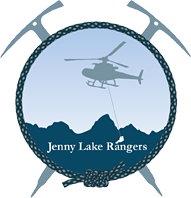PLAN AHEAD AND PREPARE
- Minimize leaving fixed protection and anchors in the mountains. Review route descriptions
to find out locations of existing rappels, belay stations and fixed pitons and minimize the creation of new/unnecessary anchors.
- Motorized drilling is not allowed. Power drills and other
motorized equipment are not permitted in the backcountry. Please consult with Jenny Lake District Ranger Chris Bellino prior to
installing any new hardware. He can be reached through the Teton Interagency Dispatch Center at (307) 739-3301.
- Do not build cairns. Cairns may assist hikers and climbers with
route-finding, but too many cairns create confusion and resource damage when
hikers are incorrectly directed off-route.
TRAVEL AND CAMP ON
DURABLE SURFACES
- Use established approach trails and routes. Do not create new approaches or descent
routes. Do not shortcut across switchbacks, as this practice causes erosion and
can destroy an otherwise good trail.
- Protect the Alpine Environment. Short growing seasons, wind, intense UV radiation, and heavy snow loads make
life in the alpine zone precarious and fragile. Plants may take 300-500 years
to recover once trampled or destroyed. Reduce your impacts on alpine vegetation
by walking on rocks and staying on trails, when available. Camp on durable
surfaces like rock or snow and not on vegetation.
- Disperse your footsteps when walking off-trail. Do not walk in a single
line through pristine alpine vegetation. Disperse your impacts to avoid creating a
new trail. When possible, walk on rocks, gravel, snow or other durable
surfaces.
DISPOSE OF WASTE
PROPERLY
- Clean up tattered anchors. Help keep the alpine environment pristine and clean up tattered anchors by cutting out worn pieces of webbing and cord from established anchors and packing it out. Remove unnecessary anchor stations. Pack out any other trash or garbage you find on routes.
- Use Rest Stop Bags. Pack out solid human waste and toilet paper on alpine climbs. There is no good place to dig a cat-hole on alpine climbing routes and solid human waste left under rocks can last a long time in that environment.
LEAVE WHAT YOU FIND
- No Construction Zone. Do not create new bivy sites by clearing ground and moving rocks. Camp on durable surfaces and use camp sites that have already been established.
- Leave cultural resources unimpaired. Do not disturb historic or
archaeological areas and structures. This includes old pitons and early climber
caches and 'trash'.
- Preserve rocks and routes. Scarring, chiseling or
gluing holds is illegal and not permitted in the park.
RESPECT WILDLIFE
- Route Sharing. Climbing routes and peaks are closed at times to protect sensitive wildlife. Ask about nesting
closures for raptors and other wildlife closures at the Jenny Lake Ranger
Station.
BE CONSIDERATE OF
OTHER VISITORS
- Be Courteous. Let faster parties pass on climbing routes when safe to do so.
- Get away from it all! Choose routes that are less popular to help alleviate overcrowding. Get an early start on climbs that are popular.
